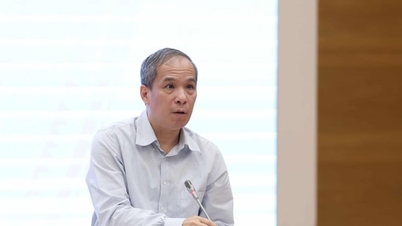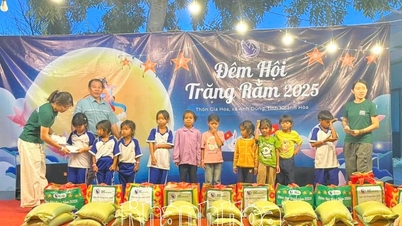
Nowadays, the public not only accesses press content on traditional addresses such as newspapers, websites, radio and television channels, but also through many other means such as social networking platforms, OTT... To meet that need, editorial offices and journalists have "covered" information on platforms, thereby reaching the maximum audience, creating more revenue. Because on platforms, views and listens (views, clicks) all turn into money, and the social networking platforms of Vinh Long Radio and Television Station, Nghe An are clear proof.
Audiences today can easily update information through Facebook accounts of major media agencies. Everyone understands that wherever readers are, newspapers will be there, but not many newspapers can do this, because realizing it is not simple.
Not only does the newsroom need to operate multiple platforms, each journalist must also be multi-tasking and proficient in all of the agency's platforms. A modern journalist needs to play many roles: writing articles, filming, editing videos , posting content... The boundaries between journalists, cameramen, photographers, and technicians are increasingly blurred. A modern journalist needs to be a "multi-media" person, mastering many skills at the same time.
First of all, journalists must understand their audience, what they want to read, watch, listen to, or how they need to interact. Do journalists have the ability to edit, process, and publish videos, graphic design, podcasts... when the audience needs it? If not, the audience has many other channels to choose from.
In addition to the ability to produce content, modern journalists also need to understand the characteristics of each media platform, as each platform has its own format, style and user base. For example, the Facebook platform is more about social interaction, so it needs short, attractive status lines or paragraphs to stimulate comments and sharing. TikTok is a short video platform, requiring vertical videos, only a few dozen seconds long, attractive from the first second to retain viewers. Meanwhile, YouTube is a suitable place for long, horizontal videos, serving viewers on computers, TVs...
Journalists cannot just produce one piece of content and then “spread” it across channels, but need to tailor it to each platform. This requires a deep understanding of user behavior, communication and promotion capabilities, and good coordination within the entire distribution channel ecosystem. Content creators also need to coordinate well with technical and business departments to optimize advertising on their content. This is not easy for many journalists, but it is an inevitable trend.
The modern journalist is not only a digital storyteller, but also a communicator - someone who understands how to distribute content strategically. In addition to being proficient in tools and software, journalists need to understand SEO (search engine optimization), analyze user data, and know how to build a personal brand on a digital platform.
Another important factor is the ability to react quickly. In a real-time news environment, journalists need to be on the scene, livestream, report quickly, and process information almost immediately. This is a big challenge because of the huge work pressure and the requirement for "lightning-like" processing speed. If journalists do not know how to manage their time and health, they can easily get tired and "lose their job".
However, professional spirit - or "professional passion" - is still the decisive factor. Many older journalists still work flexibly on multiple platforms, no less than the younger generation, showing that age is not as important as spirit and passion.
To meet the above requirements, journalists need to constantly learn and update new technologies, especially artificial intelligence (AI) applications. The application of AI not only helps save time and automate processes, but also opens up completely new ways of accessing information, editing and publishing.
In addition to the ability to work independently, teamwork skills are also essential in the modern press environment. Journalists must coordinate effectively with colleagues and different departments to create a complete content product. Soft skills such as work organization, critical thinking, and flexibility in handling situations are indispensable requirements.
And finally, no matter how much technology develops, the core values of journalism must still be preserved: journalistic ethics and professional courage. Journalists must be honest, objective and humane in all circumstances.
Changes in journalism require newsrooms to make drastic changes from recruitment, training to content production and distribution. Staff need to be equipped with multi-platform operational skills right from school, while closely following practice to avoid being left behind.
Clearly, in the digital media era, modern journalists cannot just write or shoot videos. They must “multitask”, master technology, understand the audience, master each platform, and be a good communicator to distribute content effectively, while also maintaining professional integrity. That is the way for journalists to not only survive, but also lead in their noble profession.
Source: https://hanoimoi.vn/bao-chi-da-nen-tang-va-nha-bao-da-nhiem-706360.html




![[Photo] Prime Minister Pham Minh Chinh chairs the Government's online conference with localities](https://vphoto.vietnam.vn/thumb/1200x675/vietnam/resource/IMAGE/2025/10/5/264793cfb4404c63a701d235ff43e1bd)

![[Photo] Prime Minister Pham Minh Chinh launched a peak emulation campaign to achieve achievements in celebration of the 14th National Party Congress](https://vphoto.vietnam.vn/thumb/1200x675/vietnam/resource/IMAGE/2025/10/5/8869ec5cdbc740f58fbf2ae73f065076)





















































![[VIDEO] Summary of Petrovietnam's 50th Anniversary Ceremony](https://vphoto.vietnam.vn/thumb/402x226/vietnam/resource/IMAGE/2025/10/4/abe133bdb8114793a16d4fe3e5bd0f12)

![[VIDEO] GENERAL SECRETARY TO LAM AWARDS PETROVIETNAM 8 GOLDEN WORDS: "PIONEER - EXCELLENT - SUSTAINABLE - GLOBAL"](https://vphoto.vietnam.vn/thumb/402x226/vietnam/resource/IMAGE/2025/7/23/c2fdb48863e846cfa9fb8e6ea9cf44e7)
































Comment (0)